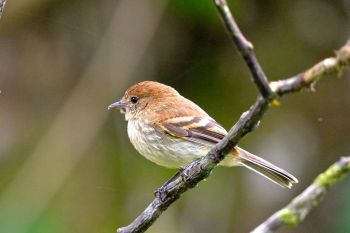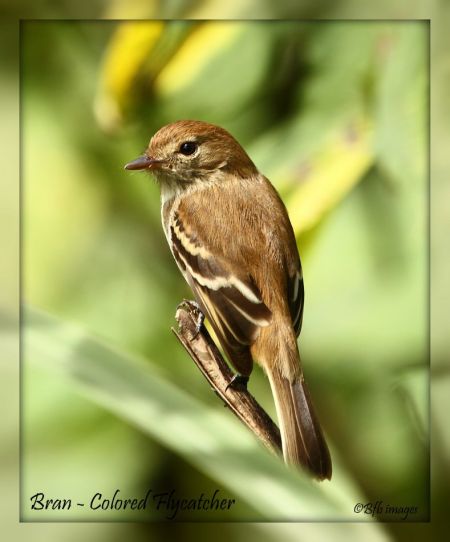- Myiophobus fasciatus
Identification
11–12·7 cm (4¼-5 in), a species usually with warm brown colors
- Often dark reddish-brown head and upperparts
- Concealed yellow crest (may in some individuals be rufous-orange)
- 2 wing bars that differ in color depending on age, sex, and subspecies
- Underparts whitish but frequently with yellow on belly
- Dark streaking on breast and flanks
- Bill: black upper mandible, brown lower mandible.
Sexes similar.
Juveniles lack crown patch.
Variation
Wing bars may be rufous when fresh and become whitish, but extent of these colors differ geographically. Likewise, subspecies may be more or less white on underside, more or less warm colored on upperside, etc.
Distribution
From Costa Rica through Central America and in South America south to Peru, Bolivia, Uruguay, northern Chile and Argentina and east to Trinidad, The Guianas and Brazil.

Photo © by Gerald Friesen
Altos De Campana National Park, Panama, February 16, 2014
Taxonomy
This species formerly included Mouse-gray Flycatcher and Rufescent Flycatcher.
Subspecies
Five subspecies are recognized[1].
- M. f. furfurosus:
- South-western Costa Rica and western Panama; winters to the Pearl Islands
- M. f. fasciatus:
- M. f. saturatus:
- Eastern Peru (San Martín to central Cuzco)
- M. f. auriceps :
- M. f. flammiceps:
Habitat
Dry forests and forest edges. Hedgerows, pastures and bush savanna.
Behaviour
Diet
Their diet consists almost entirely of insects such as small beetles, ants, wasps and flies. They also eat some berries.
Breeding
They build a deep cup nest from stems and bark, lined with fine plant fibres. It is suspended from a side branch low in a tree. The clutch contains 2 cream eggs with a rufous ring; they are incubated by the female for 17 days; the young fledge 15-17 days later.
The nest is parasitised by the Shiny Cowbird.
Vocalisation
Dawn song describes as alternating three elements of which all are relatively low pitch, short whistles. One element per second is the rule, and this can go on for minutes.
At other times of day, listen for a single whistle followed by a dry rattle. Alternatively, a single note (wee'ep) is repeated once a second for a long series.
References
- Clements, J. F., P. C. Rasmussen, T. S. Schulenberg, M. J. Iliff, T. A. Fredericks, J. A. Gerbracht, D. Lepage, A. Spencer, S. M. Billerman, B. L. Sullivan, M. Smith, and C. L. Wood. 2024. The eBird/Clements checklist of Birds of the World: v2024. Downloaded from https://www.birds.cornell.edu/clementschecklist/download/
- Restall et al. 2006. Birds of Northern South America. Yale University Press. ISBN 9780300124156
- Schulenberg, T. S. & Stotz, D. F. & Lane, D. F. & O'Neill, J. P. & Parker III, T. A. & Egg, A. B. (2010). Birds of Peru: Revised and Updated Edition. Princeton: Princeton University Press. ISBN 978-0691130231
- Kirwan, G. M., A. Farnsworth, J. del Hoyo, D. J. Lebbin, N. Collar, and P. F. D. Boesman (2022). Bran-colored Flycatcher (Myiophobus fasciatus), version 2.1. In Birds of the World (S. M. Billerman and N. D. Sly, Editors). Cornell Lab of Ornithology, Ithaca, NY, USA. https://doi.org/10.2173/bow.brcfly1.02.1
Recommended Citation
- BirdForum Opus contributors. (2025) Bran-colored Flycatcher. In: BirdForum, the forum for wild birds and birding. Retrieved 13 May 2025 from https://www.birdforum.net/opus/Bran-colored_Flycatcher
External Links
GSearch checked for 2020 platform.1





